These 12 Exercises Will Feel So Good on Your Feet
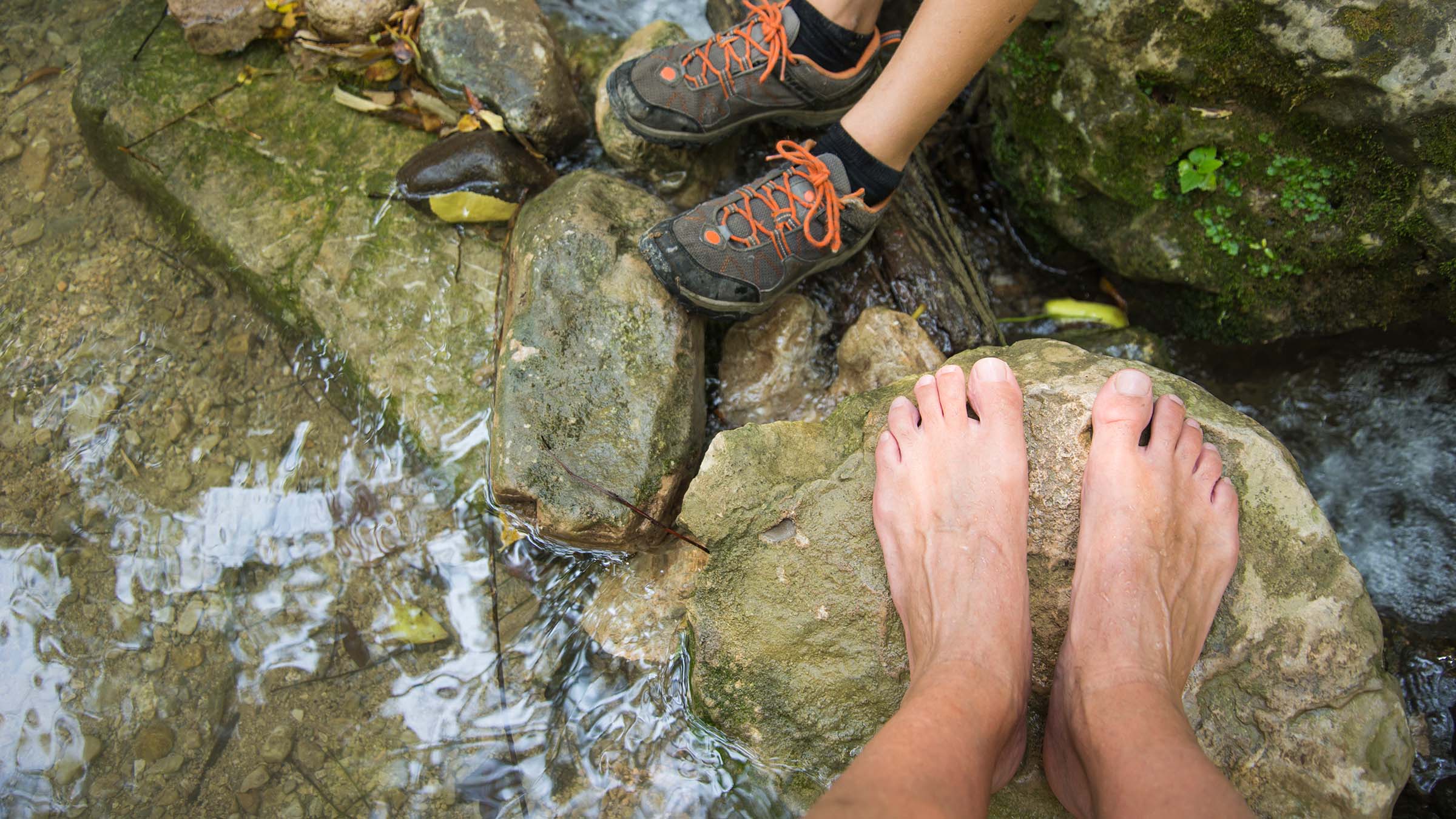
Take care of your feet and they'll carry you far. (Photo: Carlos Ciudad Photos / Moment via Getty)
Originally published in Yoga Journal
If you don’t feel especially steady at the moment, you’re not alone. Everyone’s stability wavers at times, especially during the last year and a half! You might find yourself craving the sort of steadiness that can be found through an emotional connection to yourself or others. There is a different sort of stability, though. One that you can draw on from your physical surroundings.
The term “grounding” refers to feeling secure and connected to something larger. In popular culture, grounding is typically done through a literal physical connection to the earth, such as walking barefoot. In the context of yoga, grounding means finding balance and stability. Both definitions draw steadiness from what’s beneath you. And that happens through your feet.
See also: 16 Yoga Poses to Keep You Grounded & Present
How stability through your feet works
This balance happens through specific sensory receptors, known as proprioceptors, that live in joint capsules, muscles, tendons, and fascia. Think of these proprioceptors as the ball bearings of the body. They continually exchange motor and sensory signals information with your brain cells and play a large role in motor planning, control, and adaptability. This relationship is responsible for your ability to respond to unexpected changes or new challenges in your day-to-day movements and keep your feet mobile and stable.
When you unknowingly step off a curb and your foot, ankle, knee, and hip gingerly adjust so that you can gracefully continue walking, that is a proprioception win. Conversely, if you become rigid and lock your ankle and stumble, that would be a fail.
See also Conquer Fear With These Grounding Poses
How yoga helps with proprioception
There are things you can do to increase your relationship with your environment. Your proprioceptors are stimulated when joints or connective tissue are stretched or compressed. So if there is no movement in a joint, the proprioceptors aren’t stimulated, the brain receives no input, therefore it cannot adapt its motor plan. When you wear tight shoes or if you have stiff joints, your ability to respond to your environment is lessened—sometimes drastically.
Walking barefoot on uneven surfaces is one way to challenge your proprioception. Your physical yoga practice also effectively strengthens this feedback loop. The various poses—from Warriors to arm balances—activate proprioceptors and facilitate the transmission of clear and accurate information about where your body is and how it relates to its surroundings.
Whereas proprioception helps the body instinctively adjust to the external environment, interoception brings awareness to how you are showing up internally to your surroundings. This includes much of what you experience in yoga, whether it is a sense of tension, gripping, rigidity, or fluidity of movement.
There is learning that can happen when you explore movement freely and differently in unknown situations and environments—essentially, playing. There is one caveat: to create the ideal situation for heightened body awareness and interoception, you must be in a calm and undistracted state. You cannot take in this type of experience if you are not in an open and receptive space in your mind.
If you move through Sun Salutation A thinking about what you want for dinner rather than noticing what your feet are doing, you may overlook the subtle fact that your weight is shifted too far forward or way too far back into your heels. When you are open, embodied, and receptive to that physical input, you can strengthen your body-brain connection and translate what you learn in Sun Salutes to increased stability in balancing poses such as Virabhadrasana III (Warrior III).
Performing foot-specific exercises—including stretches, mobility moves, stability work, and strengthening moves—helps build a better connection between your feet and brain, an essential component for getting grounded, finding and maintaining your balance, and moving with more grace and ease both on and off of your mat.
See also: 15 Poses Proven to Build Better Balance
How proprioception helps with life
There are reasons beyond physical stability to practice proprioception and interception. When you bring your awareness to the body and the reality of the physical experience in front of you and divert your attention away from your brain—and the running narrative and its tendency to create fiction and drama and what-ifs—you help your central nervous system actively create balanced and appropriate reactions to the internal and external signals it receives.
When you connect your body and brain in this matter repeatedly, your responses to external situations tend to be more grounded in the reality of your experience. This is analogous to the teachings of yoga, in which the physical postures are designed to draw us so into the physical experience of our body as to draw us out of the fluctuations of the mind. Just as with the physical postures, we practice this repeatedly to ensure to become more familiar with it.
This in turn affects your arousal state and your stress response, which has been shown in numerous studies to affect internal bodily functions, including digestive and immune system health. When you operate from this in-between space of balance and calm, you create stability within yourself.
12 moves to increase stability in your feet
These exercises and stretches can be done at home to reinforce the relationship between your feet and pretty much everything else.
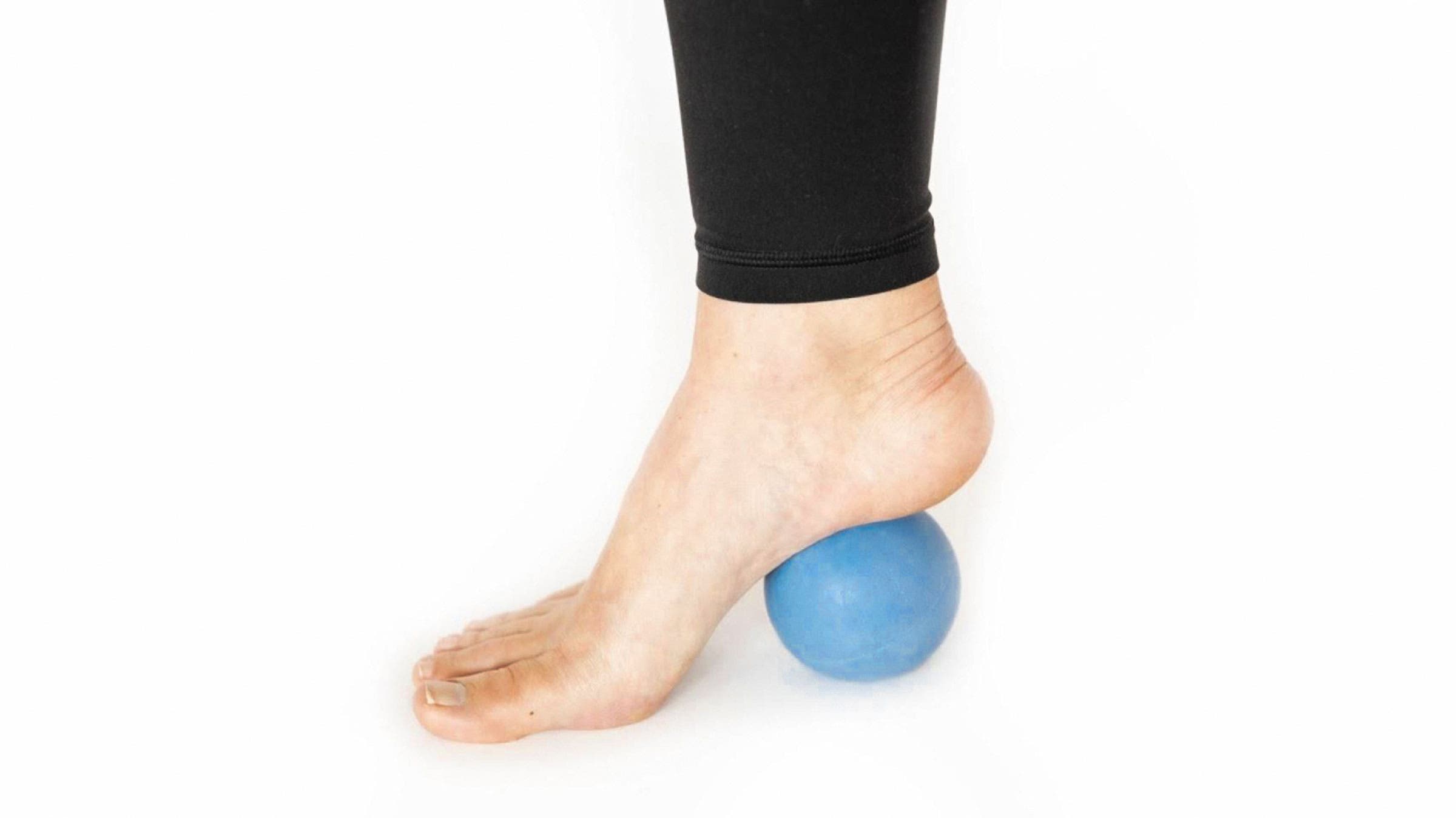
Myofascial release for the bottom of your feet
Why it helps: The muscles and tissues in your feet can tend to feel stiff and rigid as a result of many different things, including wearing shoes with inflexible soles, narrow toe boxes, high arch support, or heels; your feet moving in biomechanically incorrect form as you run, cycle, or engage in other athletic endeavors; and standing or sitting for long periods of time without much movement.
When you roll the bottom of the foot on another surface, you work through some of the tension held in the dense tissue on the bottom of your foot (plantar fascia). This can also help temporarily relieve symptoms of pesky plantar fasciitis (although the scientific research is mixed as to whether this type of exercise can actually remedy the inflammation).
How to: Start standing or seated in a chair with both your feet flat on the floor. Place a small ball or a can of soup under your right foot. Slowly roll it back and forth along your sole as you apply gentle pressure. Start at the heel on the big toe side, then roll up to the big toe knuckle, then back down to the heel, and repeat with each toe. Continue for 2-3 minutes. Switch feet.
See also: Nix Stabbing Heel Pain With 6 Yoga Stretches for Plantar Fasciitis
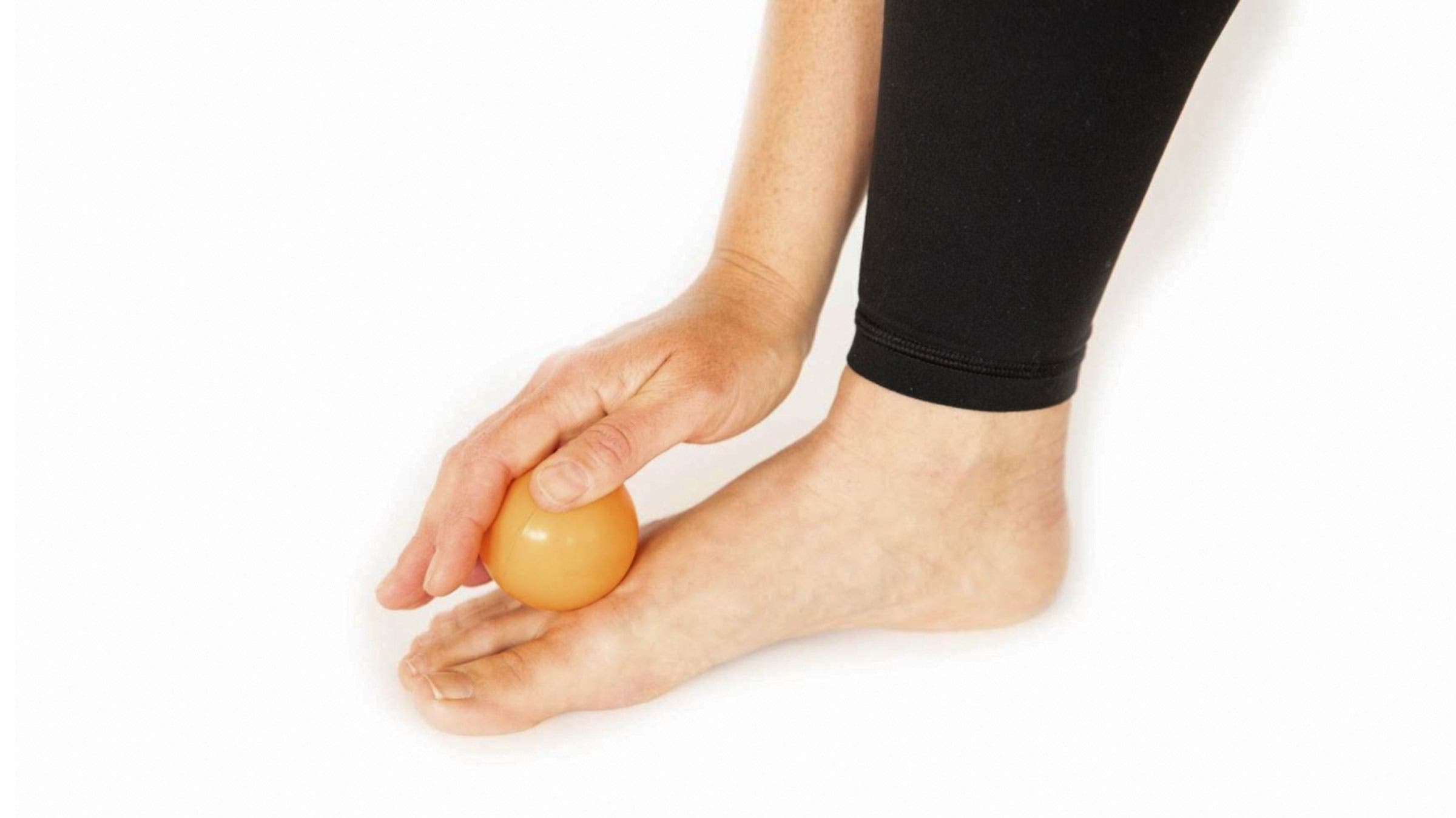
Myofascial release for the tops of your feet
Why it helps: Self-massage has value in mobilizing all the joints of the feet, similar as it does for the rest of the body. It also gives you a moment to practice self-care through touch and the time you invest in offering preventative care for yourself.
How to: Start standing or seated and hold a small ball or can of soup. Gently roll it along the top surface of your foot, making sure to massage in between each toe. Continue for 1–2 minutes. Switch feet.
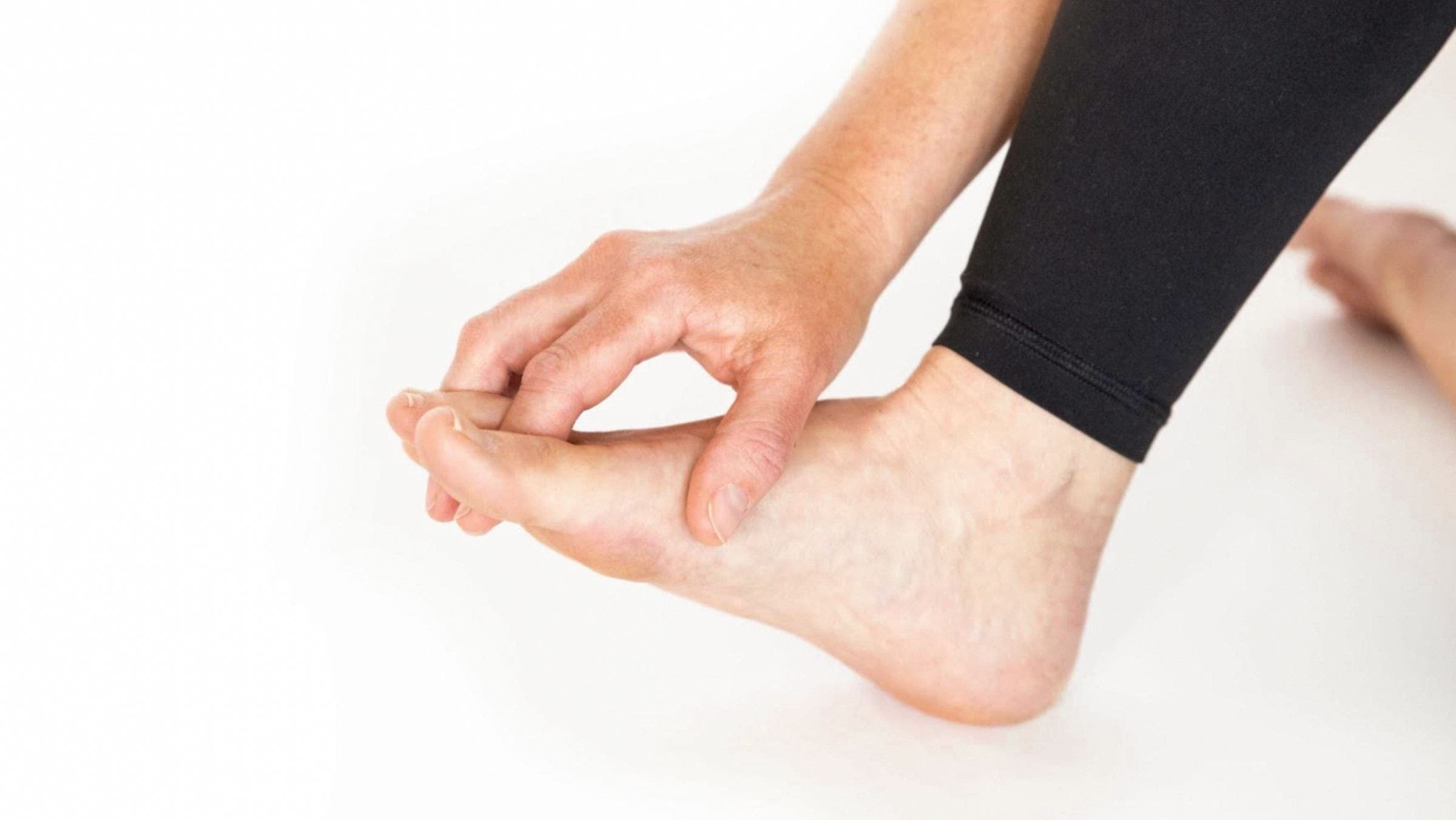
Toe stretch
Why it helps: With every step you take, your midfoot—the area between your toes and where your ankles start—should move. There are five tarsal bones in the midfoot. When you walk, these bones should spread as you land and then come back together as you propel yourself forward. The ability of these bones and your toes to move in this splaying manner is what gives the muscles in the feet the chance to contract and support the feet. If the bones do not move, the muscles do not move, and therefore are not able to contract to support you.
How to: Thread your fingers in between your toes and then spread your fingers and toes wide. Repeat 3 times. Switch feet.
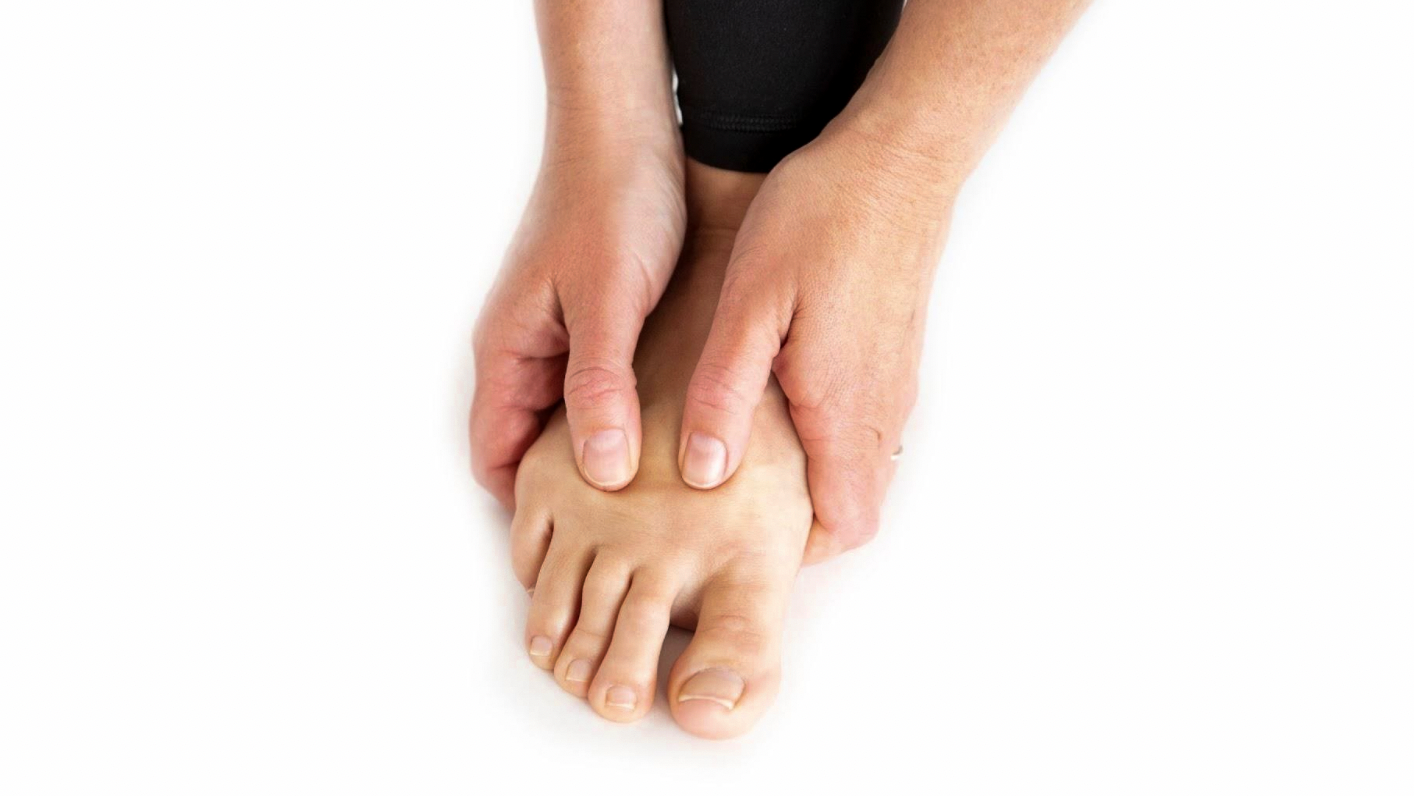
Midfoot splay
Why it helps: This stretch benefits the foot in all the same ways as the preceding toe stretch. Also, when you make time to release tension in oft-ignored places, you cultivate space between the structures of the foot as well as in between all the other tensions in your day.
How to: Gently press your thumbs on the top of your foot and bring your fingers to the bottom of it. Use your fingers to spread the soles of your feet slightly wider. Repeat for 1 minute. Switch feet.
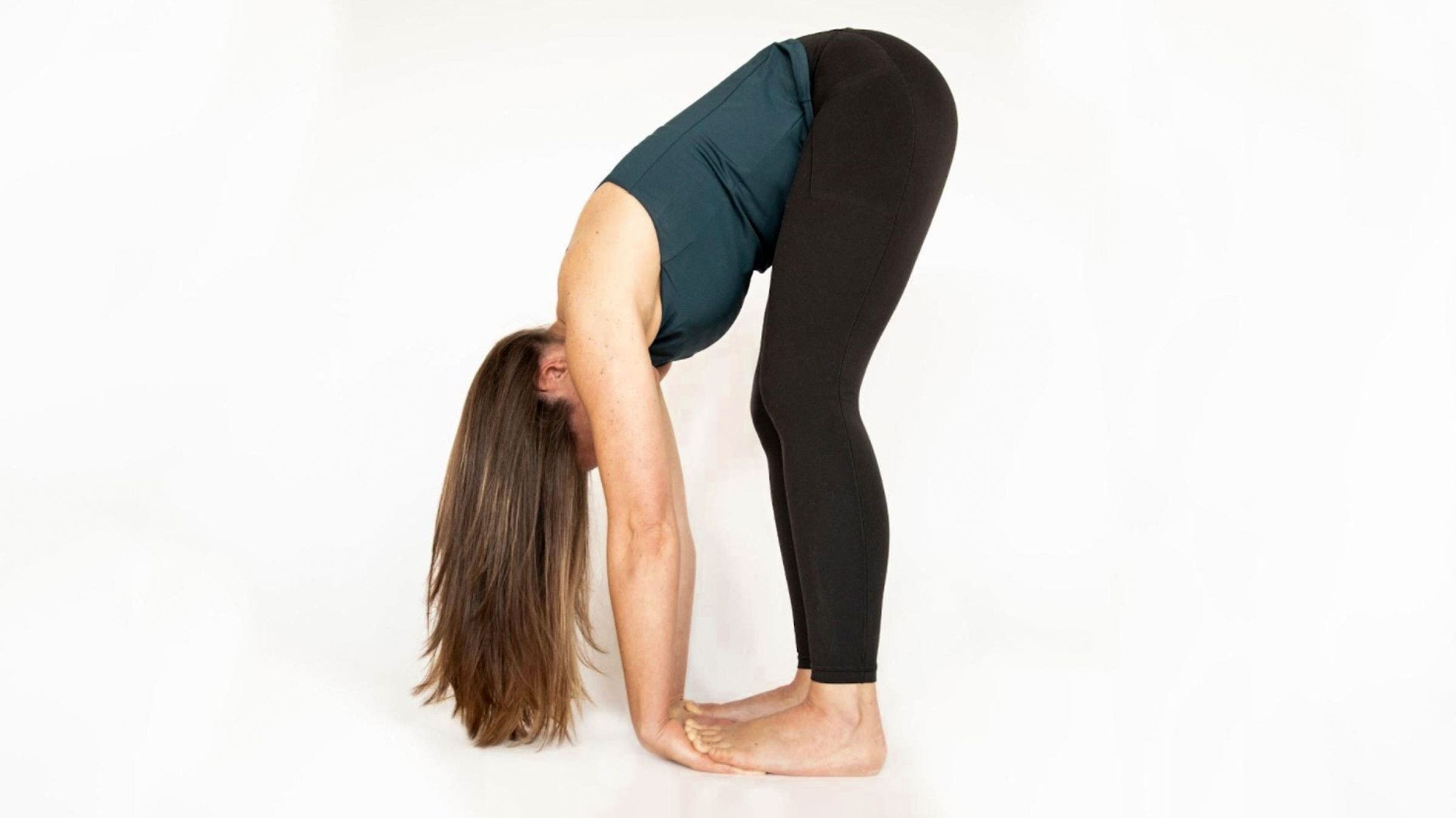
Hand-to-foot pose
Why it helps: This forward bend sends your mind the message to slow down and turn inward. It calms the nervous system. Also, the added benefit of the physical contact between hands and feet is that these body parts activate a large portion of the brain dedicated to sensory and motor function. This makes the pose an easy entry point to mind-body connection.
How to: Start in a standing position with your feet hip-distance apart or sit on a chair. Bend forward at your hips, bring your chest toward your thighs, and let your neck relax. Slide your hands beneath your feet, palms up, so your toes touch your wrist creases. If you are standing, bend your knees as much as needed to be comfortable. Remain here for 5 breaths. Slowly release.
See also: More Forward Bend Yoga Poses
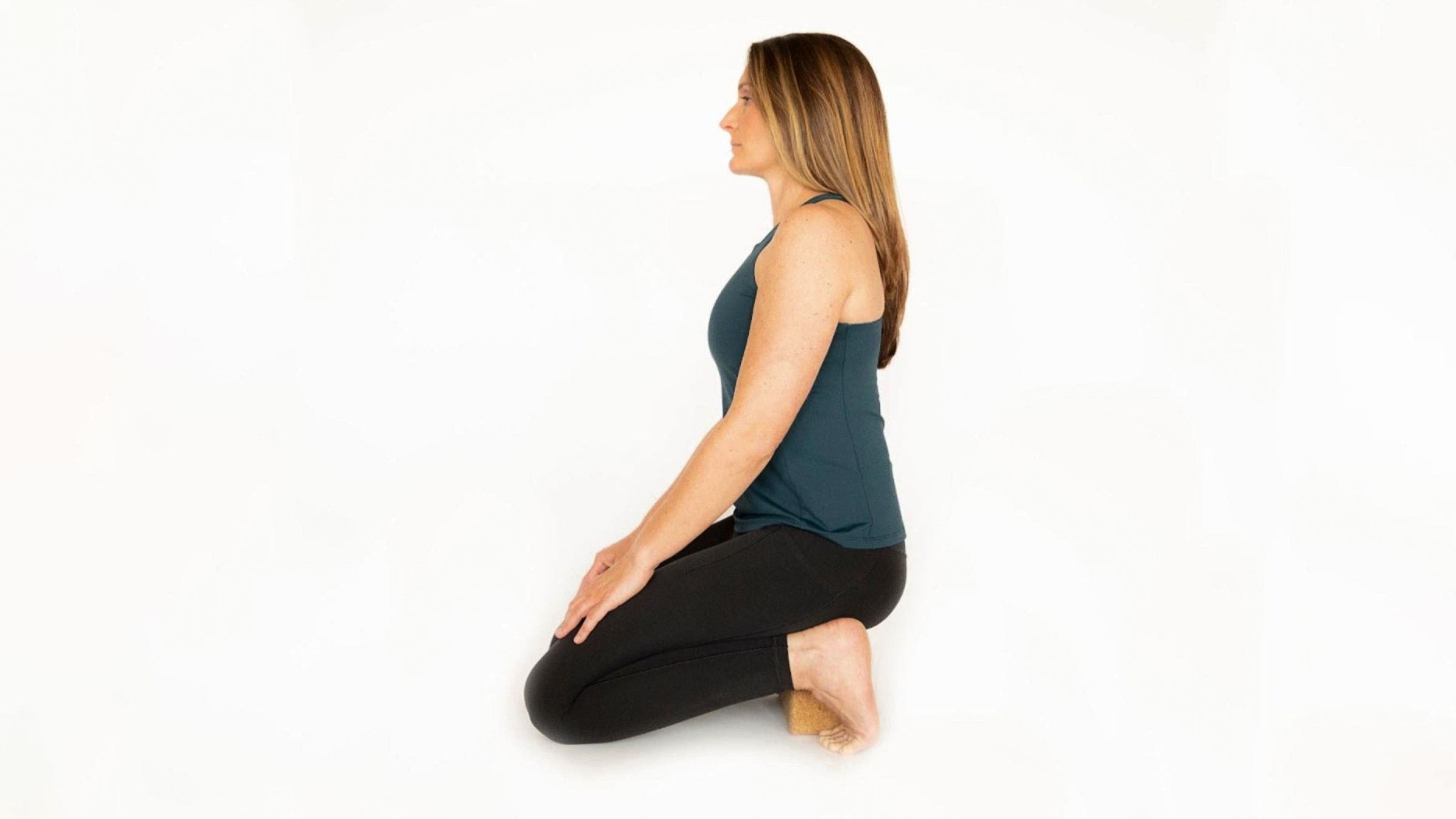
Broken toe stretch
Why it helps: With every step you take, your big toe extends into dorsiflexion. That action of pulling back is responsible for a powerful push-off from your entire foot, whether you want to walk, run, or come into High Lunge, Plank Pose, or Chaturanga Dandasana (Four-Limbed Staff Pose). This stretch helps you practice that movement.
How to: Start seated in Vajrasana (Thunderbolt Pose) with a yoga block between your ankles on the medium height and your toes flexed rather than having the tops of your feet flat on the floor. You might need to manually tuck your smaller toes under. Remain here, seated on the block, hugging your inner heels and big toe knuckles to the block and allow gravity to gently stretch the tissues that connect from the toes through the soles of both your feet. Remain here for 5–8 breaths.

Top of foot stretch
Why it helps: The tops of your feet require just as much consideration as the bottoms to keep your joints mobile. This stretch is especially helpful for the midfoot bones and creates space from the toes to the front of the shin bone to help bring stability to almost any standing position. It can also potentially bring relief from pain related to shin splints.
How to: Start seated in Vajrasana, which is a variation of Virasana, with a yoga block between your ankles on medium height. Use your left hand to lift your left knee until you feel a stretch in the top of your left foot. This is usually a few inches off the floor. Remain here for 4–6 breaths. Switch feet.
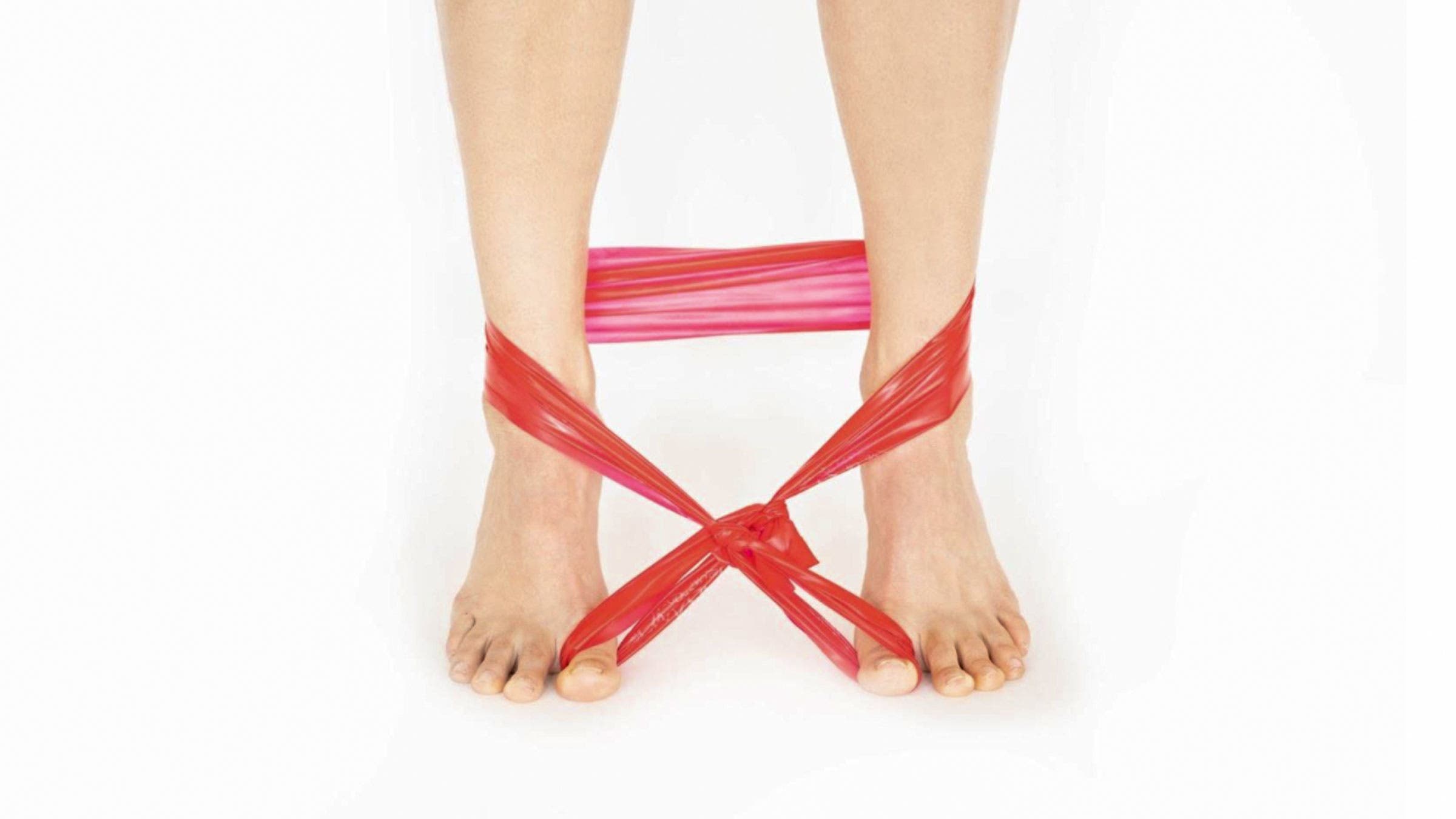
Band big toe and ankles
Why it helps: When you wrap a resistance band around the big toes and ankles, it requires awareness to maintain a strong connection between your big toe and the ground. Focus on pressing outward with your ankles so you don’t collapse your arches inward toward one another. This awareness will serve you in almost any standing posture.
How to: Wrap a resistance band around the backs of both legs, just above your ankles, then cross it in front of your ankles. Loop one end around each toe before securely tying the ends of the band so it is taut but your feet remain under your hips. (We used a red Theraband band that is medium resistance.) Slowly lift your heels off the ground, coming to balance on the balls of feet. Lower back down and repeat for a total of 30 seconds.
See also: Anatomy 101: Get to Know the Ankle Joint
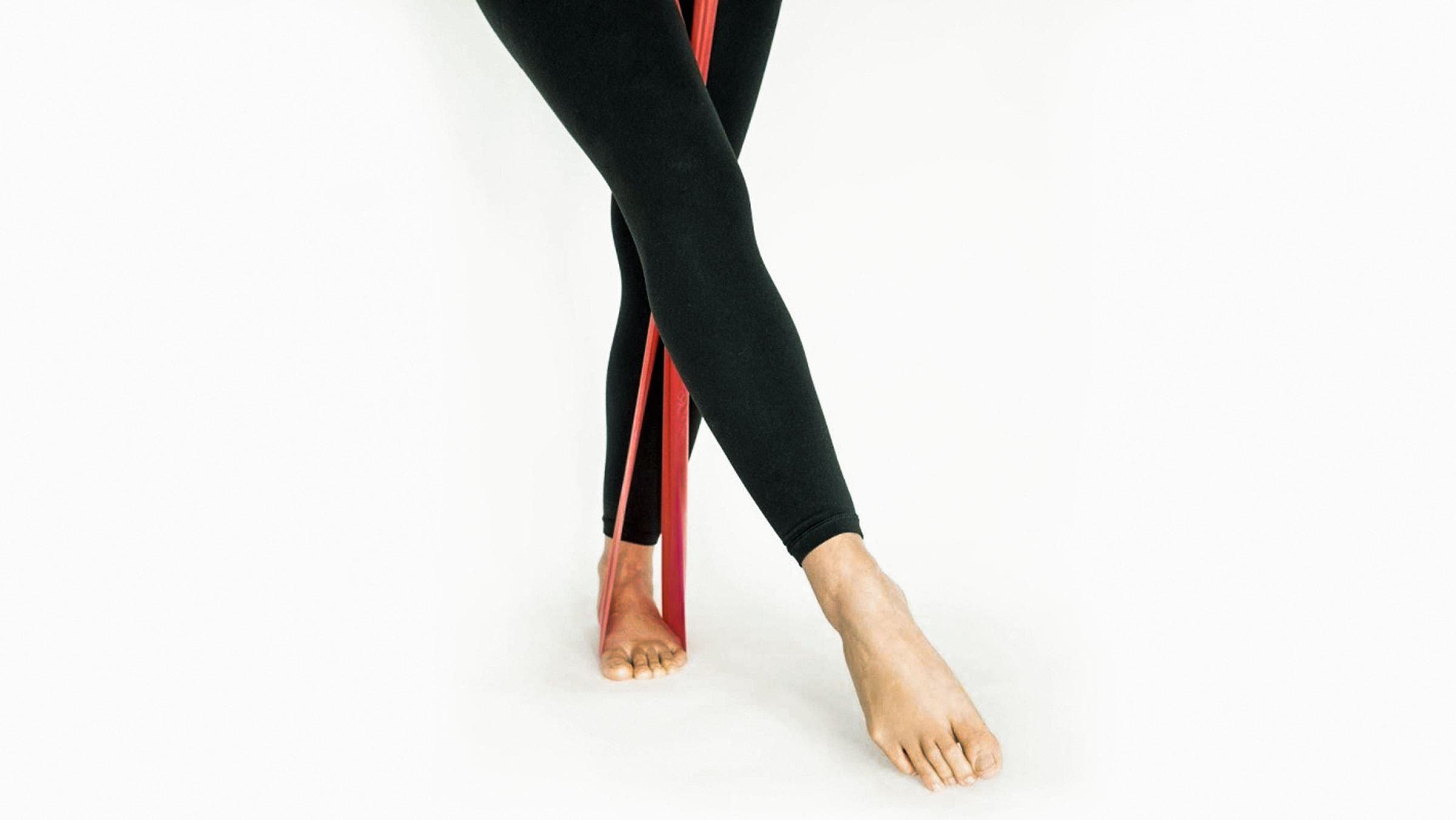
Toe taps clock
Why it helps: When you ground through your big toe knuckle, your feet, ankles, knees, hips, and pelvic floor are each set up for success. This exercise challenges your standing, banded foot to remain evenly balanced and connected to the floor as you move the opposite leg into different positions. This recruits the smaller stabilizing muscles within the foot, which is helpful in any balancing pose in yoga. The added dynamic challenge is functional practice for single-leg transitions into Garudasana (Eagle Pose) or everyday activities including climbing stairs.
How to: Start standing with a resistance band wrapped under the big toe joint of your left foot and hold the ends of the band in your hands. Extend your right foot forward and lift your right toes into the air a few inches, then begin tapping them in a circle around your body as if you were marking the numbers on a clock face, moving clockwise (10, 12, 3, 6, 9 where 12 is in front of you, 6 is behind you, 3 and 9 are to the sides.). Switch feet.
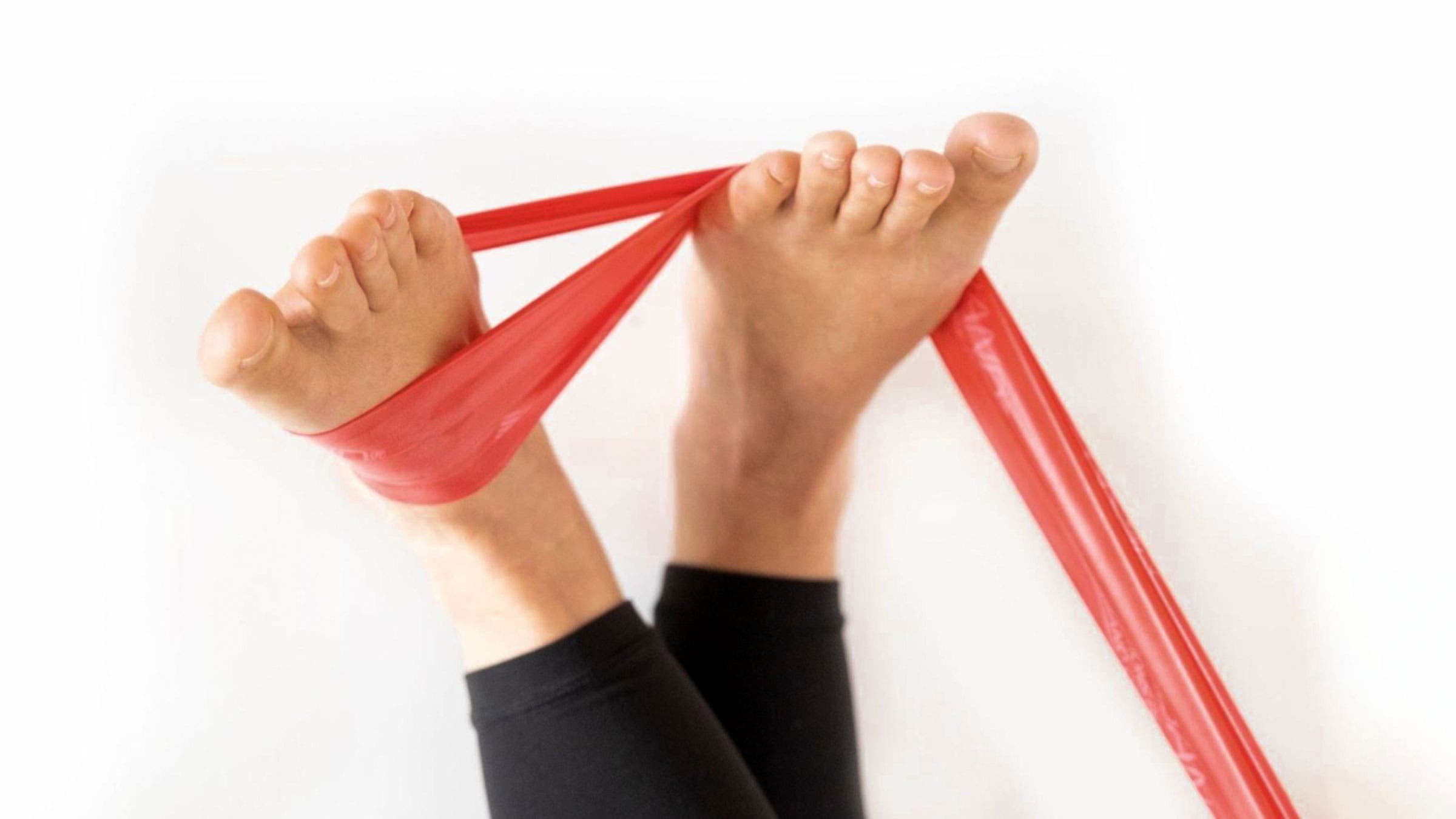
Eversion With Band
Why it helps: Side-to-side movements can train the muscles that help stabilize your foot and ankle during dynamic balancing such as in Vrksasana (Tree Pose) as well as the challenging transition from Tree Pose to Virabhadrasana II (Warrior II).
How to: Start seated on the floor with your legs extended straight in front of you and your feet flexed back toward you. Loop a resistance band around your right foot, then place your left foot on top of the looped band so there’s tension between your feet. Hold both ends of the band in your left hand. Slowly rotate your right foot to the right side, then back through the center, and over to the left side. Continue for 30 seconds. Repeat on your other foot.
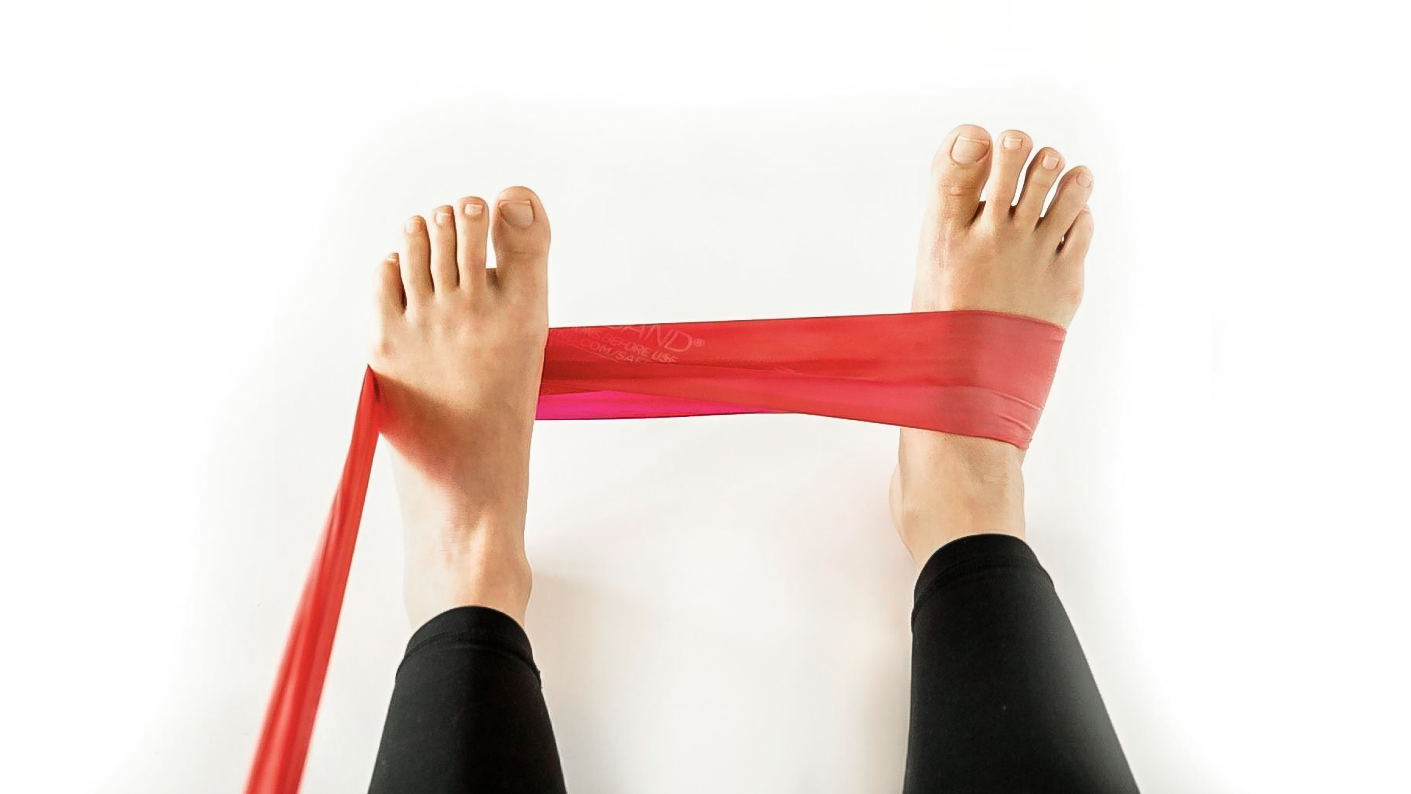
Inversion with band
Why it helps: This movement works in a similar fashion as the preceding exercise to train the muscles that help stabilize the foot and ankle in side-to-side movements. When you know the feeling of inversion and eversion, you can be more conscious of keeping your ankle neutral during yoga poses.
How to: Still seated on the floor with your legs extended, cross your right leg over your left. Loop a resistance band around the arch of your left foot, then pass the band behind your right foot so there’s tension between your feet and hold both ends in your left hand. Slowly rotate your left foot to left side, then back through center and over to left side. Continue for 30 seconds. Repeat on your other foot.
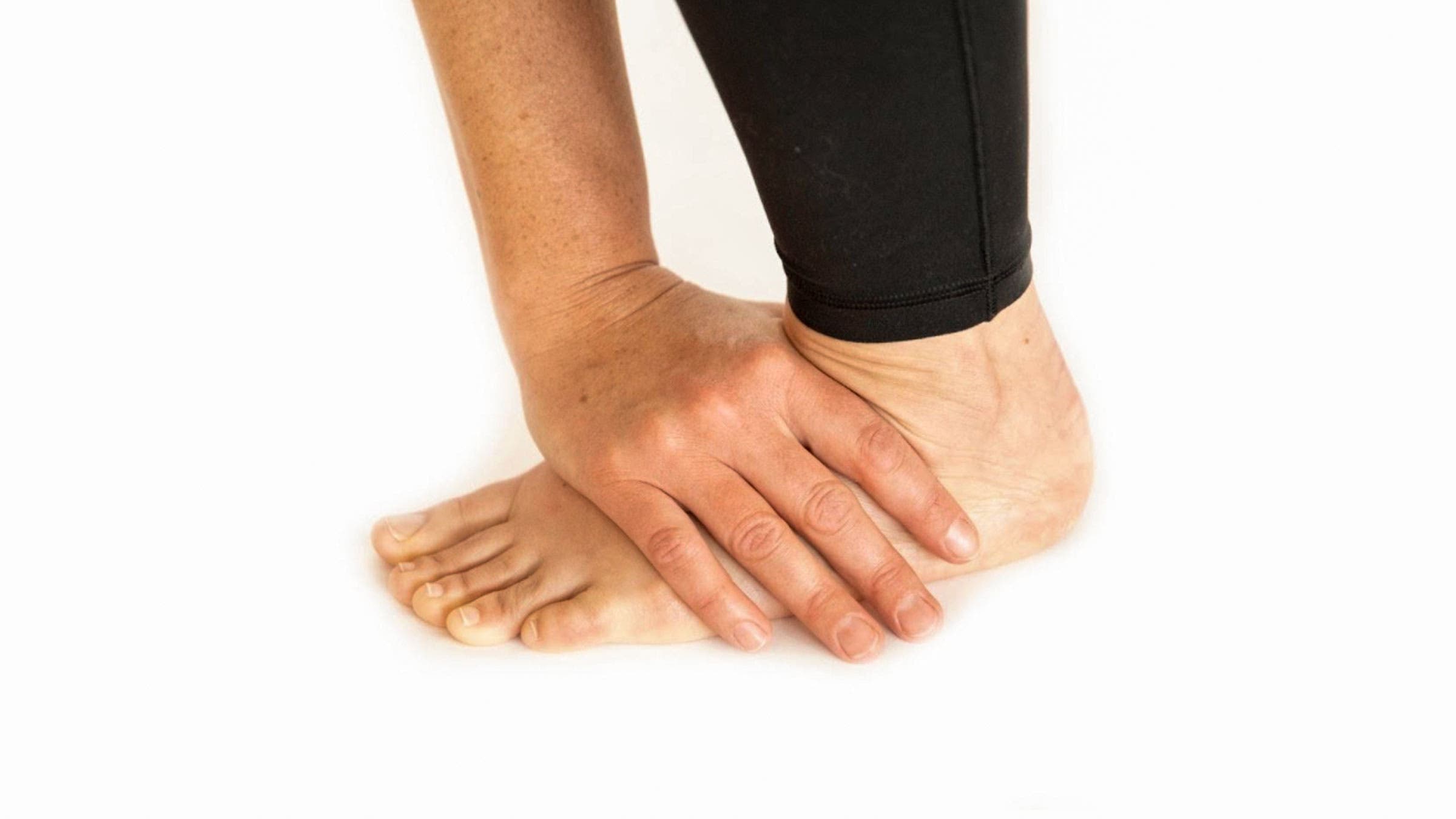
Ankle dorsiflexion stretch
Why it helps: Some people experience a trickier time with flexion of the foot than others. Practicing it can help with your steadiness in Utkatasana (Chair Pose), Malasana (Garland Pose), and standing balancing poses. Being able to dorsiflex can also can bring more ease to Adho Mukha Svanasana (Downward-Facing Dog Pose).
How to: Start in a kneeling lunge position. Left foot forward, right foot back. Place your left hand across the top of your foot. Bend your left knee as far as you can while you keep your entire left foot and heel on the ground. Remain here for 1 minute.
See also: 6 Foot, Toe, & Ankle Stretches to Improve Your Yoga Poses